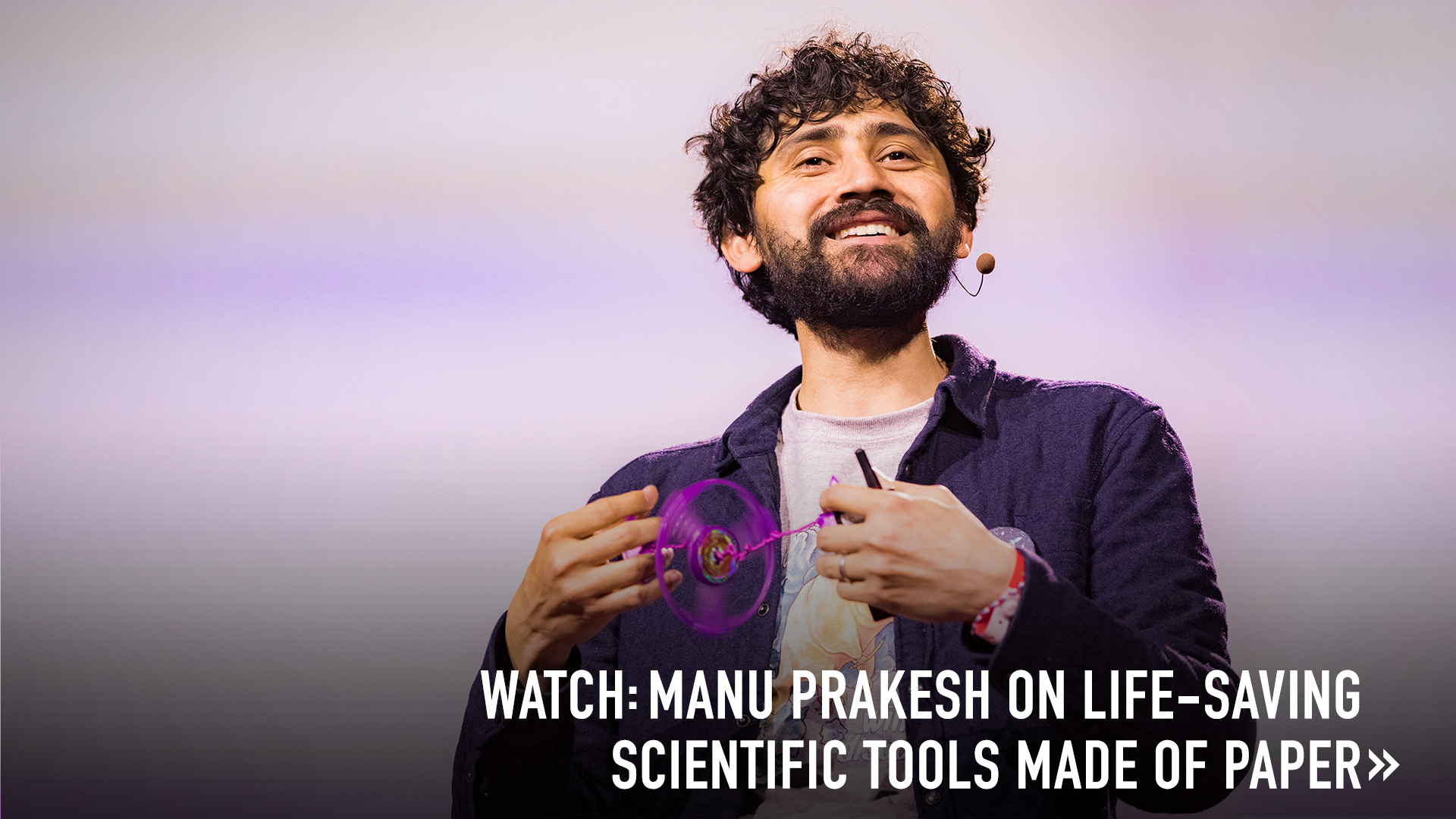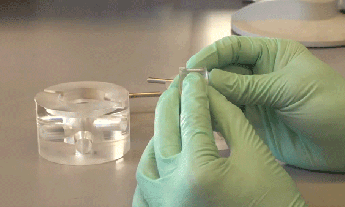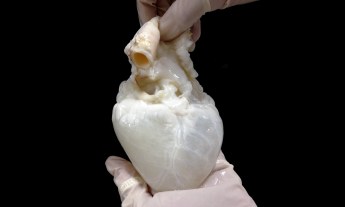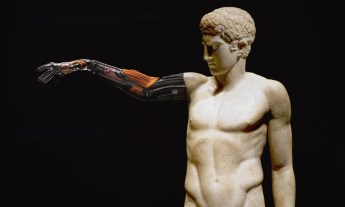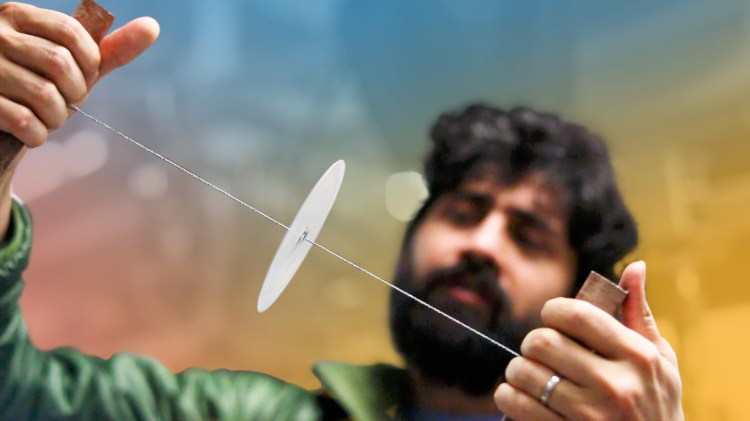
Bioengineering professor Manu Prakash brought the world a 50-cent microscope. Now he’s created more cheap public health tools, including a paper centrifuge and a mosquito identifier. And he’s just getting started.
While many of us may look at a sheet of paper and see something to write on, Stanford University bioengineering professor Manu Prakash sees groundbreaking scientific technology. He’s probably best known for creating the Foldscope — a paper microscope that’s been shared with thousands of people all over the world (TED Talk: A 50-cent microscope that folds like origami). Recently, Prakash, a TED Fellow, unveiled two new low- or no-cost health tools: the Paperfuge, a paper centrifuge that enables the diagnosis of diseases in remote areas, and Abuzz, an app that allows people to upload the sounds of mosquitoes so the insects can be mapped to track the spread of illnesses they carry.
Why medicine needs a spin cycle. In health care, centrifuges — devices that whirl blood and other fluids at super-high speeds (more than 15,000 RPM) and separate it into its various components — are a crucial piece of equipment for detecting diseases. However, they are expensive (costing from hundreds to thousands of dollars), heavy, and require a power source to function, putting them out of reach for poor or remote communities. After Prakash visited a Uganda health clinic and spied a centrifuge being used as a pricey doorstop (there was no electricity to power it), he realized the need for a cheap, non-electric model.
To create game-changing technology, he looked at children’s games. Prakash wasn’t the first person to want to create a cheap centrifuge — other researchers have experimented with egg beaters and salad spinners, but those gadgets topped out at a relatively sluggish 1,200 RPM. So he and his team at the Prakash Lab turned to kids’ toys for inspiration, trying tops (they couldn’t spin long or fast enough); yo-yos (they demanded too much skill and consistency to throw well); and, finally, whirligigs. Dating back to 3,300 BC, a button whirligig consists of a button or disc that sits in the middle of a loop of string — when you grasp an end of the string in each hand and pull, the button spins.
Prakash’s version consists of a pair of 10-centimeter reinforced paper discs strung on a braided fishing line, with a wooden handle at the end of each piece of string. Straws are attached to the discs and serve as tubular valves to hold tiny vials — called capillaries — of blood samples to be spun. His Paperfuge can reach up to 125,000 RPM and separates plasma from whole blood in less than one-and-a-half minutes. A conventional device takes around two minutes to do the same task and costs $1,000–$5,000. The estimated cost of materials for Prakash’s model? Twenty cents.
The simplest blood test: checking for anemia. To use the Paperfuge to find out if you have anemia, you just need to prick a finger, put some drops of blood in a capillary, insert that into the straw on the disc, and seal it with clay. After 90 seconds of spinning, a human’s naked eye can discern the ratio of blood cells to plasma, says Prakash. A low red blood cell-to-plasma ratio might signify anemia.
Of course, many diseases can’t be diagnosed by simply eyeballing a blood sample. Diseases such as HIV or tuberculosis can be detected through rapid diagnostic tests (RDTs), which are much more effective when plasma is used instead of blood samples. “If you put whole blood in such tests, they confuse the signal,“ says Prakash. “But if you use only plasma, those same tests are extremely accurate.” Prakash’s lab has developed a more complex Paperfuge which has diagnostic tests embedded in the disc itself. “The blood is placed into a capillary that’s integrated into the disc. When you spin gently at first, you get the separation. And when you spin harder, you break the valve which goes to the next step where the plasma is channeled using centrifugal microfluidics — rotating force that directs fluid in different directions — into capillaries preloaded with reagents.” The disc can then be examined under a microscope. There is a downside, however: this disc can be used just once, whereas the original Paperfuge discs may be used indefinitely.
Malaria causes more than one million deaths a year; fifteen minutes of spinning with the Paperfuge can separate malaria parasites from blood, allowing them to be seen when a sample is analyzed under a microscope. Now, Prakash is busy brainstorming how to make a better Paperfuge just for malaria detection. “We’re thinking of integrating an actual detector in the Paperfuge itself — like placing a tiny microscope on top of the centrifuge — so that when you spin a malaria sample, you could also detect it with the same device,” he says. “Ideally, a health worker can simply load the sample and spin.”
Another useful test material: tiger dung. Also in development at the Prakash Lab: a Paperfuge that extracts DNA. “We’ve made one that separates nucleic acids, which allows you to extract DNA from biological samples,” says Prakash. Working in collaboration with scientists who are using genomics to track and study tigers in India, Prakash is helping them avoid having their biological samples — in this case, tiger scat — become unusable. “When you carry these samples around for days, over time the DNA starts to deteriorate and cells start to die,” he says. “One solution is to extract the DNA, which has all the information that you need if you want to do further tests that are nucleic acid-based.”
The original Paperfuges are now being tested by health professionals. Prakash is on the board of a nonprofit in Madagascar called Pivot, which develops community health infrastructure and partners with the government to perform research and deploy services. “We have training programs in place that can try out Paperfuge,” he says. “And we’ll be leaving them out in the field for healthcare workers to try. We want to prove that they not only work in our labs but they can also hold up to the rigors of the field.”
Another new endeavor: decoding and mapping mosquitoes. Prakash also recently launched Abuzz, a web-based project that enlists people to record the sounds of mosquitos with their mobile phones and upload them to a site. The buzzes go into a database complete with a time and location stamp, and in return, Abuzz sends back a species name, a photograph to help identify the specimen, and the probability that it’s carrying a vector-borne disease, an infection transmitted by the bite of infected arthropod species, such as mosquitoes, ticks, sandflies and blackflies. The result, according to Prakash, is a real-time map of where mosquitoes are spawning and biting, which can help people, public health officials, and scientists monitor and control the spread of diseases like Zika and malaria.
“One important aspect of control is to be able to know where the carriers are,” says Prakash. “On the website is a map that shows where the recording was made, and from there you can see whether anyone around you has noticed the same mosquito. This alerts people for the need to, say, make their family sleep under a bed net, or look for and clear out breeding sites. It also helps local authorities pinpoint their control efforts.”
Mosquitoes are a fact of life for almost everyone on Earth. Currently three billion people worldwide are at risk of contracting mosquito-borne illnesses. “Aedes aegyptai, one of the carriers of dengue, Zika and yellow fever, has traveled around the globe — not because it can fly across the Pacific but because of tires being shipped globally that contain the insects. We’ve spread mosquitoes, and therefore diseases, around the world,” says Prakash.
Part of what inspired him to create Abuzz was his own relationship with mosquitoes. “As a child in India, I got malaria a couple of times; everybody gets it. We used to sleep under nets, but they’d sneak under there, too,” he says. “In the morning when I woke up, I’d kill the mosquitoes that fed on me. We want to channel some of that anger into doing something positive to help fight the problem.”
Abuzz will let researchers see the big picture of how and where mosquitoes travel and proliferate. “Scientists are interested in patterns. What’s beautiful about mosquito populations is that you’ll see nothing, nothing, nothing in a season — and boom, they’ll grow exponentially for a while and then suddenly their numbers will crash,” Prakash says. “At the moment, we don’t have baseline data for the abundance and location for specific species. Once we do, it’ll be easier to track how they respond to the weather, spraying and so on.”
Should we use the data to eliminate mosquitoes with genetic modification or other strategies? Prakash is not sure. However, Abuzz could help us answer that question. “Every species has all kinds of ecosystem roles in play, but the stakes are very high here because eliminating a disease is important,” he says. But undertaking such a large-scale ecological initiative requires strong evidence, so scientists need to build up the data first. “My focus is building measurement techniques to be able to bring the type of precision we have in astronomy and cell biology to mosquito ecology,” Prakash says. “Hundreds of times in human history, we’ve acted with good intentions and had bad results. So I believe in measurements. Citizens need to be part of this effort to collect data, because scientists can’t be everywhere.”

